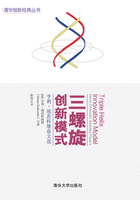
参考文献
[1]Barnes B, Dolby R G A. The scientific ethos: a deviant viewpoint[J]. European Journal of Sociology, 1970, 11: 3-25.
[2]Beyerchen A. Onthe stimulation of excellence in Wilhelmian science[M]//Dukes J, Remack J. Another Germany: a reconsideratin of the imperial era. Boulder, CO: Westview Press, 1988: 139-168.
[3]Bok D. Beyond the Ivory Tower: Social Responsibilities of the Modern University[M]. Cambridge, MA: Harvard University Press, 1982.
[4]Cotgrove S, Box S. Science, Industry and Society[M]. London: Allenand Unwin, 1970.
[5]Culliton B. The academic industrial complex[J]. Science, 1982, 216: 960-962.
[6]Dickson D. The New Politicsof Science[M]. New York: Pantheon, 1984.
[7]Etzkowitz H. Entrepreneurial scientists and entrepreneurial universities in American academic science[J]. Minerva, 1983, 21: 198-233.
[8]Etzkowitz H. A Research University in Flux: University-Industry Interactions in Two Departments[R]. Report to the National Science Foundation, 1984, June 15.
[9]Etzkowitz H. Responses to ‘pathologies of science’[J]. Social Epistemology, 1987, 1: 261-64.
[10]Etzkowitz H. Molecular biology: the new modes[J]. Science, 1988, 242: 602-603.
[11]Etzkowitz H. The making of an entrepreneurial university[M]//Mendelsohn E, Merritt Roecoming a Smith, Weingart P. Science and the Military. Dordrecht, Holland: Reidel.
[12]Etzkowitz H. Decentralization by default: the regionalization of United States industrial and science coming b policy[J]. Theory and Society.
[13]Gerson M. Ontario unveils $200-million program to spur collaboration between universities and industry[Z]. Chronicle of Higher Education July, 1987, 22: 25.
[14]Gilbert G N, Mulkay M. Opening Pandora's Box: A Sociological Analysis of Scientists' Discourse[M]. New York: Cambridge University Press, 1984.
[15]Glaser B. Organizational Scientists[M]. Indianapolis, IN: Bobbs Merill, 1964.
[16]Goldhor R, Lund R. University-to-industry advanced technology transfer: a case study[J]. Research Policy, 1983, 12: 121-52.
[17]Hall S. Invisible Frontiers: The Race to Synthesize a Human Gene[M]. New York: Atlantic Monthly Press, 1987.
[18]Jones L V, Land G, Coggeshall P E. An Assessment of Research-Doctorate Programs in the United States[M]. Washington, DC: National Academy Press, 1982.
[19]Kornhauser W. Scientists in Industr[Z]. Berkeley, CA: University of California, 1959.
[20]Krimsky S. The new corporate identity of the American university[J]. Alternatives, 1987, 14: 20-21.
[21]Krimsky S. University entrepreneurism and the public purpose[M]//de Forest P, Frankel M,Poindexter J, et al. Biotechnology: professional issues and social concern. Washington, DC: American Association for the Advancement of Science, 1988.
[22]Latour B, Woolgar S. Laboratory Life[M]. Beverly Hills, CA: Sage, 1979.
[23]Lynch M. Art and Artifact in Laboratory Science: A Study of Shop Work and Shop Talk in A Research Laboratory[M]. London: Routledge and Kegan Paul, 1984.
[24]Mitchell C. Case and situation analysis[J]. Sociological Review, 1983, 31: 187-211.
[25]Marcson S. The Scientist in American Industry[M]. New York: Harper, 1960.
[26]MertonR K. Science and technology in a democratic order[J]. Journal of Legal and Political Science, 1942, 1: 115-26.
[27]Merton R K. The ambivalence of scientists[J]. Bulletin of the Johns Hopkins Hospital, 1963, 112: 77-97.
[28]Mitroff I. Norms and counter-norms in a select group of the Apollo Moon scientists: a case study of the ambivalence of scientists[J]. American Sociological Review, 1974, 39: 579-95.
[29]National Science Board. Science and Engineering Indicators[Z]. Washington, DC: National Science Board, 1987.
[30]National Science Foundation. Evaluation of the National Science Foundation Industry/University Cooperative Research Centers: Description and Correlative Findings[Z]. Washington, DC: National Science Foundation, 1986.
[31]Nelkin D. Science as Intellectual Property[M]. New York: Macmillan, 1984.
[32]Nevins A. The State Universities and Democracy[M]. Urbana, IL: University of Illinois Press, 1962.
[33]Noble D, Nancy P. The plastic tower: business goes back to college[J]. The Nation September, 1980, 20: 233, 246-252.
[34]Pelz D, Frank A. Scientists in Organizations[Z]. Ann Arbor, MI: Institute of Social Research, 1976.
[35]PollackA. Battles beginning in race to patent superconductors[J]. New York Times, 1988, 2: 1-34.
[36]Pollack R. Biologists in pinstripes: science pauses for a corporate fling[Z]. The Sciences October, 1982: 35-37.
[37]Reams B. University-Industry Research Partnerships[Z]. Westport, CT: Quorum Books, 1986.
[38]Samuelson P. Innovation and competition: conflicts over intellectual property rights in new technologies[J]. Science, Technology and Human Values, 1987, 11: 6-21.
[39]Schwarzkopf A, Directorate for Engineering, Division of Cross-Disciplinary Research, NSF, Interviewed by Etzkowitz, Jan. 6, 1989.
[40]Stehr N. The ethos of science revisited: social and cognitive norms[J]. Sociological Inquiry, 1976, 48: 173-196.
[41]Webster D. America's highest ranked graduate schools, 1925-1982[J]. Change May/June, 1983: 14-24.
[42]Yoo O. Nobel winner plans new genetics corp[J]. The Harvard Crimson July, 1987, 28: 1.

(扫描二维码,可阅读英文原文)